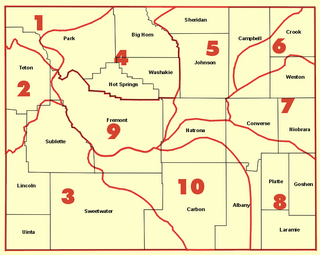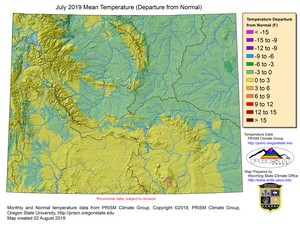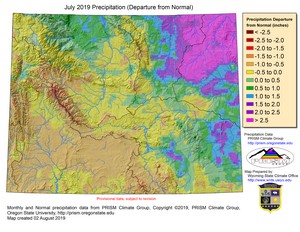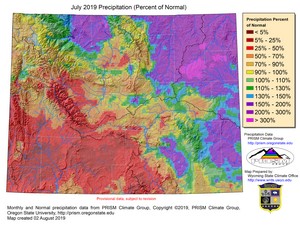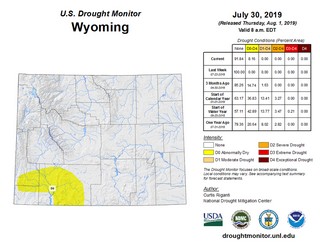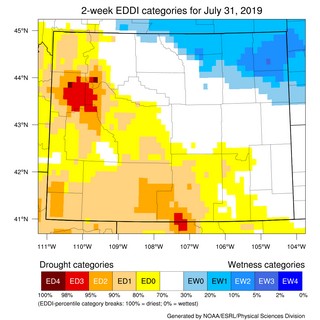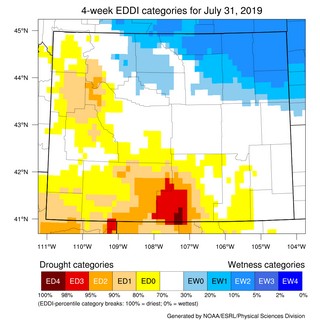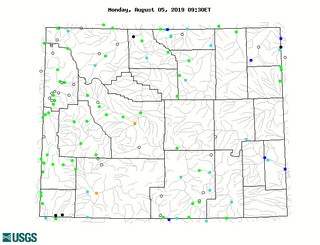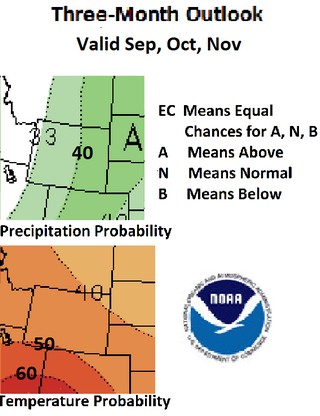 | |
 | |
| WRDS/SCO is currently working remotely so there may be a slight delay returning phone calls. Please email wrds@uwyo.edu if you are in need of information and we will respond as soon as possible |
|
| ||||||||||||
Drought Impacts and Outlook Summaries - 15 August 2019View this Summary as a PDF
Highlights for the State
Wyoming experienced its 45th warmest July of the last 125 years. Only Climate Divisions (CD) 5 and 6, in the northeast, had rankings that were in the cooler half of years. These two divisions saw their 55th and 43rd coolest Julys, respectively. CD 10 had the lowest warm ranking finishing the month as the 29th warmest July since 1895. The range of rankings for precipitation rankings was wider during July with CDs 3 and 10 in the southwest having the driest rankings at 5 and 6 respectively out of 125. CDs 4 and 5 in north central Wyoming were at the other end of the ranking and had the 32nd and 29th wettest Julys since 1895. August (thru the 7th) has had above-normal temperatures across most of the state with the northwest being somewhat more above-normal than other portions. Precipitation has been varied across the state though mostly below normal. The northwest has the highest number of stations that are, so far, reporting above-normal precipitation for August.
Drought During the last week of July a large area of D0 (Abnormally Dry) formed in the southwest covering about the northern quarter of Uinta County, parts of southern Lincoln County, and about 60% of Sweetwater County. While many areas of Wyoming have seen beneficial moisture this summer, the southwest has received less than normal amounts and this pattern is expected to continue into August. Evaporative Demand in that part of the state is above average. Drought conditions are expected to continue in the southwest and the area could see an expansion both in terms of area and intensity.
Evaporative Demand The Evaporative Demand Drought Index (EDDI) for the last two weeks of July is showing normal to low-demand conditions across the northeastern half of Wyoming and above normal demand for the southwestern half. Looking at the conditions over the last two weeks, an area of concern has developed northwest Wyoming along the Teton-Fremont County border while a longer-term (4-week timeframe) area has developed in southwestern Carbon County. Additional products can be found at: http://www.wrds.uwyo.edu/sitemap.html Do you have drought impacts to report? We need your on-the-ground reports and you can input them here: http://droughtreporter.unl.edu/submitreport/
Water Resources Reservoir conditions may be viewed online in larger format at: http://www.wrds.uwyo.edu/surface_water/teacups.html Streamflows in Wyoming are at or above normal with the exception of a half dozen in the one station each in Fremont and Sweetwater Counties. The map below shows streamflow conditions in Wyoming as of August 05.
Weather and Climate Outlooks For temperature over the next two weeks, the southern part of the state has better chances of being above-normal while the last week in August could see above, below, or normal temperatures in most of the northern half of the state with below-normal temperatures possible in the extreme northern part. Drought conditions could continue to expand in areas in the southwestern half of Wyoming. Much of this area is experiencing higher than normal evaporative demand and is more likely to have below-normal precipitation and above-normal temperatures over the next two to three weeks.
You can help us
Heard around the State Weston Co., Jul 5: "Second great year in a row! Very abnormal in my 60+ years of memory. Sweet clover everywhere and 4ft high." Goshen Co., Jul 6: "The garden and grass are almost too wet. Some of the xeriscape plants we put in are turning yellow. The trees are in good condition. The reservoirs are all full." Sweetwater Co., Jul 13: "Dry conditions require increased irrigation demands. Also high fire danger due to high temps and low humidity." Washakie Co., Jul 20: "Lawns, gardens, fields all drying out! Fire danger increasing! With temps in the 90's, folks are hiding out inside with the AC."
Partners
Stay Tuned and In Touch The Wind River Indian Reservation and Surrounding Area Conditions may be found here: https://hprcc.unl.edu/windriver.php |
||||||||||||



